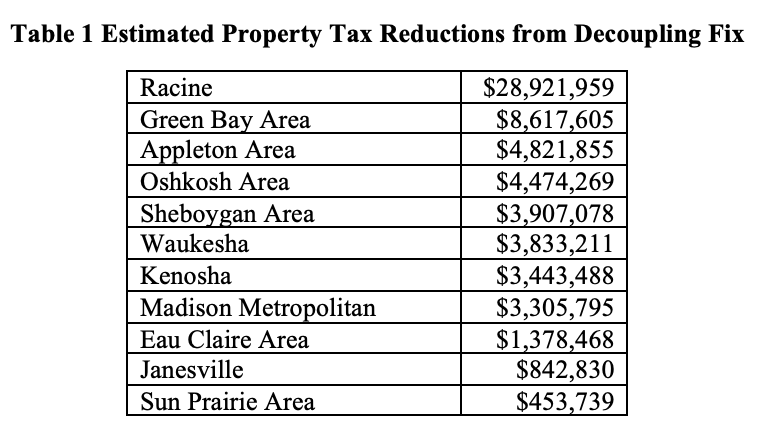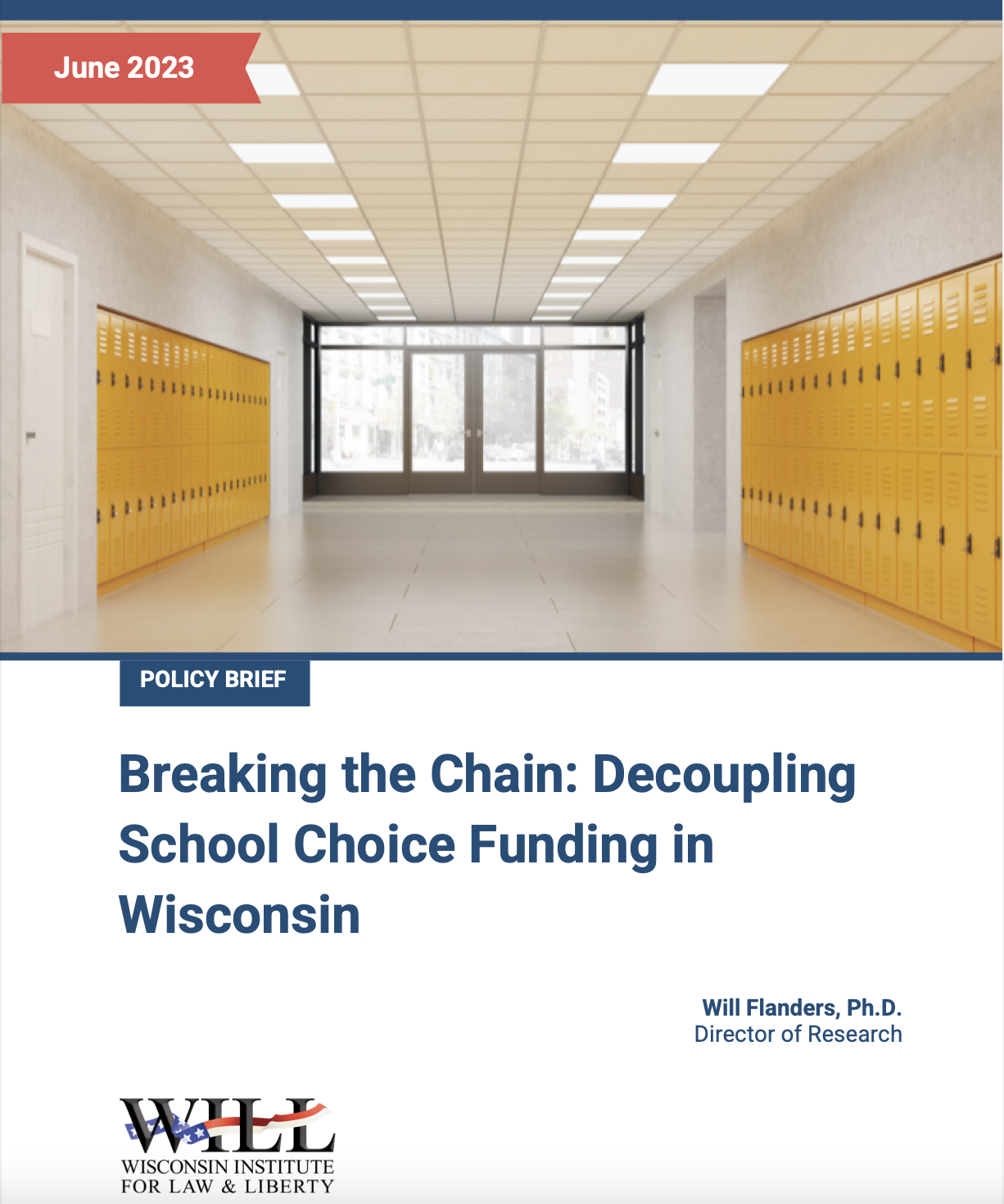Introduction
School choice in Wisconsin is undergoing some exciting changes. With the likely passage of increased funding for the state’s voucher programs, participating schools will be on firmer financial footing going forward. This better financial condition is likely to also lead to a growth in the number of seats available in the state’s choice schools. But while this was a critical win for Wisconsin’s kids, there is another equally important policy that is still under consideration: decoupling choice spending from public school spending. In this policy brief, we explore how private schools in the choice program are currently funded, and why decoupling would be an important improvement.
The Current System
The focus of this brief is on the Wisconsin and Racine Parental Choice Programs. A remedy has already been applied to the Milwaukee Parental Choice Program, which will be discussed later on.
To understand the complex way funding currently works, consider a hypothetical 100 students. Suppose that 90 attend a public school district and the other 10 students are on a K-8 voucher.
Each district in the state has a revenue limit that represents the total amount of funding they are allocated to fund their local schools. It is based largely on the amounts that were being spent in each district in the mid-1990s, with some changes in more recent years. An important factor to keep in mind is that the overall revenue limit has no relationship to the number of voucher students at this stage. For our hypothetical school district, let’s assume the overall revenue limit is $1,200,000.
Schools are funded by state aid and by local property taxes. For the most part, any specific district’s share of state aid versus property taxes is based on that district’s property wealth. Generally speaking, districts with higher property values receive less state aid, while districts with lower property values receive more money in state aid. For our hypothetical, let’s assume that this district receives $8,000 in state aid per student. Just for the moment, let’s table the fact that 10 of the students are on vouchers.

The district would use property taxes to fund the remainder of its spending up to the revenue limit. Since our hypothetical revenue limit is $1.2 million, and we currently have $800,000 accounted for by state aid, this district can look to property tax for the remaining $400,000:
Property Tax Calculation
$1,200,000 – $800,000 = $400,000
Now, the voucher funding system adds another layer of complexity to this. Our hypothetical district then has its state aid funding reduced by the amount of the voucher, which under the newly enacted system, would be $9,499 per student. This means that the district “loses” $94,990 in state aid—but the district is then allowed to make up that money with property tax increases. The resulting funding looks like this:

Property Tax Calculation
$1,200,000 – $705,100 = $495,000
The resulting funding per student is the same, but property taxpayers are “on the hook” for $94,900 more than they would be without this adjustment.
Decoupling
Under decoupling, the students that receive a voucher are fully funded by the state via General Purpose Revenue (GPR). Additionally, the district would no longer count the students enrolled in the choice program in their enrollment count for funding purposes. However, the revenue limit of the district would remain unchanged at $1,200,000. The district receives state aid for each enrolled student, and property taxes fund the remainder:

Property Tax Calculation
$1,200,000 – $720,000 = $480,000
Under decoupling, property taxes in this hypothetical district would be reduced by approximately $14,900 (from just over $494,900 to $480,000).
The Milwaukee Parental Choice Program is already on the road to decoupling. The share of the program that is funded by property taxes in the district has been slowly phased out over several years, with the full phase-out occurring by the 2024-25 school year. There is little reason not to apply a similar policy to the state’s other (and faster growing) private school choice programs.
What would these property tax savings look like in the real world? We can estimate the savings to property taxpayers by looking at the revenue limit increases provided to districts for the choice program. Statewide, this would represent a property tax cut of more than $168 million. The potential property tax savings in the ten largest districts other than Milwaukee are reported below:

These numbers likely underestimate due to growing enrollment in the choice programs and the inclusion of independent charter schools—which face the same funding issue—in decoupling as well.
Advantages
While the choice program, with lower funding than traditional public schools, still represents an overall saving to taxpayers, school districts have long used the property tax implications as a cudgel against the program. Some districts include the cost of the program on mailers to taxpayers, and the Governor has proposed mandating such information be included across the state in the past. Making this change would remove an important arrow from the quiver of choice opponents, while also removing the argument from public schools that voucher schools are “costing them money.”
Perhaps even more critically, this change would help to insulate the school choice program from constitutional challenges. Since it was first instituted, school choice in Wisconsin has been upheld multiple times by courts. Nevertheless, changes to the composition of the Wisconsin Supreme Court could reignite potential challenges to the program anyway. Article X § 2 of the Wisconsin Constitution provides that property tax revenue be used “to the support and maintenance of common schools, in each school district, and the purchase of suitable libraries and apparatus therefor.” It is explicitly not the case that property taxes are directly used to fund the existing voucher programs. But there is a danger that an unfriendly state Supreme Court may creatively interpret the circuitous route which funding takes (as described above) as somehow interfering with the funding of public schools. Removing the connection to property taxes in the current system would remove this potential argument against the constitutionality of the program.
Conclusion
School funding in Wisconsin is complex even when only the public-school side of things is considered. But the state’s choice programs currently add complexity, which is not just a concern for bookkeepers—it confuses taxpayers about what the school choice program is costing them. By funding the choice program with GPR, the legislature can simplify the system, reduce misguided complaints from local school districts about funding “cuts,” and insulate the program from Constitutional challenge.
Sources
[i]https://www.jsonline.com/story/news/education/2018/12/27/racine-includes-voucher-school-costs-property-tax-bills/2380891002/#:~:text=According%20to%20the%20city%2C%20at%20least%20%2418.7%20million,in%20one%20of%20the%20state%27s%20Parental%20Choice%20programs.
[ii] https://www.wpr.org/evers-wants-property-tax-bills-show-cost-voucher-schools#:~:text=Democratic%20Gov.-elect%20Tony%20Evers%20said%20Wednesday%20that%20he,a%20Democratic%20governor%20in%20Wisconsin%20in%20eight%20years
[iii]https://docs.legis.wisconsin.gov/misc/lfb/informational_papers/january_2023/0030_private_school_choice_and_special_needs_scholarship_programs_informational_paper_30.pdf
[iv] https://will-law.org/wp-content/uploads/2021/07/FundEveryKidv101.pdf

BREAKING THE CHAIN: DECOUPLING SCHOOL CHOICE FUNDING IN WISCONSIN
Will Flanders, PhD | June 2023
